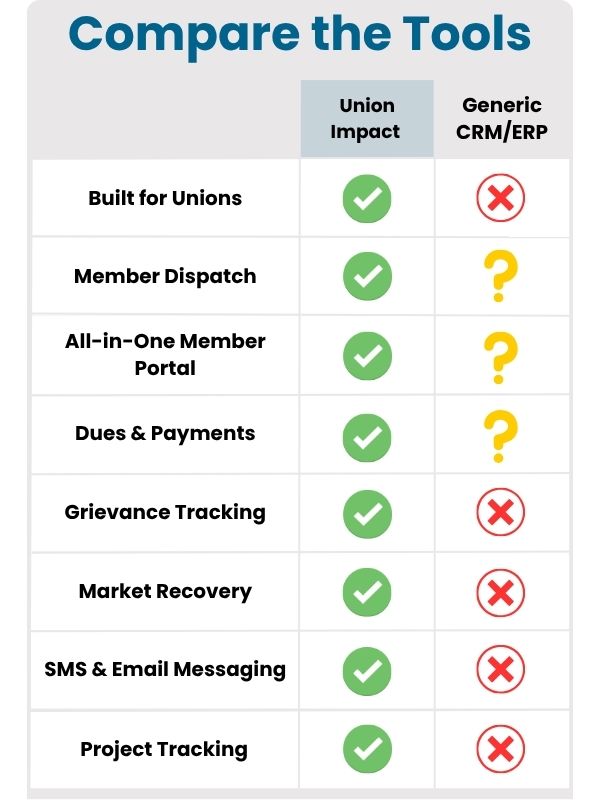Choosing the Best Union Management Software:
A Complete Buyer’s Guide
Union leaders today are pulled in every direction.
You’re fighting off anti‑union legislation, recruiting and retaining members in a changing labor market, and trying to deliver fast, professional service to the members you already represent. Meanwhile, the back office is juggling spreadsheets, aging databases, paper files, and one‑off tools that don’t talk to each other.
It’s not just frustrating—it costs time, money, and trust.
Modern union management software is how many locals, district councils, and international unions are solving that problem. This guide is designed to help you:
Understand what “union management software” really is
Identify the features that actually matter for unions (not generic associations)
Build a realistic requirements list and budget
Ask the right questions when you talk to vendors
See how a purpose‑built platform like Union Impact fits into that picture Union Impact Software+1
You can use this as a working document when you evaluate options and prepare for demos.
1. What Is Union Management Software?
Union management software is an all‑in‑one system built to run the day‑to‑day operations of a union, local, or labor association.
Instead of separate tools for membership, dues, dispatch, grievances, projects, and messaging, it brings everything into a single, connected platform. For example, Union Impact centralizes: Union Management Software
Member database & profiles
Dues & payment tracking
Automated job dispatching
Grievance tracking & follow‑ups
Project and jobsite management
Market recovery tracking
Mass messaging (text & email)
Member portals & apps for self‑service
Reporting & compliance support
Think of it as a union‑specific CRM + dispatch system + back‑office hub.
The goal isn’t just “going digital.” The goal is to:
Replace silos with a single source of truth
Standardize and automate processes
Make it easier for members to interact with their union
Give leadership real‑time visibility into what’s happening across the organization

Serving American Locals: Our platform is built to support unions across the United States, with U.S. locals operating on our U.S.-based systems to keep everything aligned with domestic operations and member needs.

Serving Canadian Locals: Canadian unions are supported through dedicated Canadian infrastructure, ensuring your local’s data, workflows, and member services remain inside Canada—built for Canadian unions, by a team that supports them every day.
2. Why Unions Are Moving to Modern Software Now
2.1 One Connected System Instead of Silos
When information is scattered across spreadsheets, old Access databases, paper files, and staff inboxes:
Members get inconsistent answers
Staff re‑enter the same data multiple times
Reporting is painful (and often late)
Turnover means institutional memory walks out the door
An integrated system like Union Impact ties everything together: member records, dues history, dispatch eligibility, grievances, projects, and communications live in one secure place. Union Impact Software+1
That means:
Changes made once are reflected everywhere
Everyone is working with the same information
Data is ready for reporting and compliance without manual compilation
2.2 Better Communication and Member Experience
Members expect the same kind of digital experience they get from banks, airlines, and utilities: fast, transparent, and available 24/7.
Union management software should make it easy to:
Send targeted text and email updates (e.g., job calls, meeting reminders, action alerts)
Communicate with specific groups (apprentices, retirees, stewards, certain trades, or specific contractors)
Give members secure online access to their information, dues balance, and job calls through a member portal or app Union Impact Software
Done right, this reduces phone calls to the hall and makes the union feel more responsive and connected.
2.3 Data‑Driven Decisions
With modern software, leadership doesn’t have to guess.
Dashboards and reports should give quick visibility into:
Active vs. inactive members
Dues compliance by local, contractor, job classification, or jurisdiction
Grievance volume, types, and time‑to‑resolution
Dispatch trends and open calls
Market recovery and project coverage across your territory Union Impact Software+1
Instead of pulling numbers manually from half a dozen tools, staff can generate audit‑ready or bargaining‑ready reports in minutes.
2.4 Efficiency and Automation
The right system should remove busywork, not create more.
Examples of automation that unions typically benefit from:
Dues payments automatically updating member status and dispatch eligibility
Expired certifications blocking dispatch until renewed
Follow‑up reminders for staff tasks (site visits, grievance steps, callbacks)
Automatic logs of every communication and action taken on a member or project Union Impact Software+1
This doesn’t replace staff—it lets them spend more time on high‑value work: member advocacy, organizing, and negotiations.
2.5 Compliance and Audit Readiness
Unions operate under strict reporting and record‑keeping requirements. A modern union management system should help you:
Maintain complete audit trails of dues payments, dispatch actions, grievances, and follow‑ups
Store key documents (contracts, MOUs, grievances, decisions, notes) alongside relevant members or projects
Generate reports for Department of Labor filings or third‑party audits without a last‑minute scramble Union Impact Software+1
Union Impact, for example, logs actions across modules and provides dedicated reporting tools that support compliance and leadership accountability. Union Impact Software+1

Our platform is hosted only in SOC 2 Type II / SOC 3 Type II–audited data centers, giving you a proven compliance baseline from day one.
Nightly Off-Site Backups
Your data is backed up automatically every night to a separate, secure data center—so you’re protected from accidental loss or hardware failures.
Security You Can Trust
Your connection to our system is encrypted with HTTPS (SSL/TLS) using 2048-bit certificates, ensuring your data stays private and tamper-resistant in transit.
3. Essential Union Management Software Features (Checklist)
This section doubles as your requirements list. As you evaluate systems, mark each feature as:
✅ Must‑have
⬜ Nice‑to‑have
⬜ Not needed
3.1 Membership & Contact Management
Your member database should be the heart of the system.
Look for:
A centralized profile for each member with contact info, classifications, certifications, dues status, dispatch eligibility, and history
Support for different member types (journeyman, apprentice, retiree, associate, staff, etc.)
Custom fields to match your specific contracts, trades, or internal codes
Family, employer, or contractor relationships
Complete history of actions, notes, grievances, and communications per member Union Impact Software
Questions to ask vendors:
Can we configure fields without custom development?
How easy is it to bulk update members (e.g., rate changes, classification changes)?
Can we track membership across multiple locals or councils if needed?
3.2 Dues & Payment Management
Dues and finances are too critical to manage in spreadsheets.
Look for:
Recurring and one‑off dues, assessments, and special funds
Multiple payment sources (members, employers, benefit funds)
Online payments through a secure gateway
Flexible rates by classification, jurisdiction, or employer
Receipts and payment histories tied back to member profiles
Export or integration with your accounting system Union Impact Software+1
In Union Impact, for example, unions can collect, track, and report on dues and assessments with options for automated billing and member‑level reporting, while also supporting batch recording of payments. Union Impact Software+1
Questions to ask:
How do you handle employer remittances and reconciliation?
Can we run aging reports by contractor or local?
What safeguards prevent misapplied or duplicate payments?
3.3 Dispatch & Job Call Management
This is where generic CRM systems usually fail unions.
Look for:
Rules‑based dispatch (seniority, certifications, out‑of‑work lists, job type, and availability)
Ability to match members to jobs based on skill sets, certifications, and location
Automated communication of job calls via text, email, or portal
Transparent logs showing why a particular member was dispatched to a job Union Impact Software+1
Union Impact’s dispatch tools are built specifically for union halls, so staff can automate call‑outs, reduce congestion at the hall, and maintain fairness and accountability. Union Impact Software+1
Questions to ask:
Can the system enforce our unique dispatch rules without custom coding?
How does it handle no‑shows or declined calls?
Can members check their status and job calls online?
3.4 Grievance & Case Management
Grievances are mission‑critical. Losing track of one case can damage trust.
Look for:
Digital intake forms or simple logging of grievances by staff
Case assignment, deadlines, and escalations
The ability to attach documents, meeting notes, and correspondence
Status tracking and history over the life of the grievance
Reporting by issue type, employer, contract, or region Union Impact Software+1
Union Impact includes dedicated grievance tracking and follow‑ups so you can log, assign, and resolve cases with full documentation and reminders. Union Impact Software
Questions to ask:
How does your system ensure deadlines don’t get missed?
Can members see the status of their grievance?
Can we export case data for bargaining or legal review?
3.5 Organizing Tools
For unions growing membership and jurisdiction, organizing tools should be part of the platform—not a separate spreadsheet or app.
Look for:
Prospect and campaign tracking (sites, leads, employers)
Digital intake forms and event sign‑ups
Geo‑mapping to visualize projects and activity across your jurisdiction
Segmented follow‑up lists and messaging for organizers Union Impact Software+1
Union Impact’s organizing capabilities include project tracking, market recovery tools, and mapping so reps can see union and non‑union activity and plan outreach strategically. Union Impact Software
Questions to ask:
Can we track both union and non‑union projects?
Do organizing tools connect back to the main member and project database?
Can we generate reports for campaigns and organizing drives?

Dedicated Infrastructure: Your security is our priority. Every client receives their own dedicated server, meaning your data is never co-mingled with anyone else’s. This private environment ensures maximum security and performance.
Choose a reliable partner that follows the latest security protocols.
3.6 Member Communication & Engagement
Communication should come from the same system that holds member data.
Look for:
Integrated SMS and email messaging
Targeted segments (by local, job classification, employer, jurisdiction, or project)
Message templates for common updates (job calls, meetings, campaigns)
Logs of messages sent to each member for transparency and history Union Impact Software+1
Union Impact provides mass messaging via text and email, integrated with member records and dispatch workflows. Union Impact Software
Questions to ask:
Is texting built in or via a third‑party add‑on?
Can non‑technical staff set up and send messages?
How are opt‑outs and preferences handled?
3.7 Member Portals & Apps
Self‑service options save staff time and improve member satisfaction.
Look for portals or apps that allow members to:
Update their contact information
View and pay dues
See job calls and dispatch status
Access documents (contracts, agreements, forms, letters)
RSVP to events and trainings Union Impact Software+1
Union Impact offers member portals and apps as part of its web services, giving members mobile‑friendly access to their information and union resources. Union Impact Software
Questions to ask:
Is the portal fully integrated with the core system?
Can we control what different member types see?
Is there a mobile app, and what devices does it support?
3.8 Events, Meetings, and Training
Most unions run a constant calendar of meetings, trainings, and rallies.
Look for:
Event creation and promotion
Online registration and payment (where applicable)
Attendance tracking, including integration with member records
Reporting on participation and engagement by member or group Union Impact Software
Questions to ask:
Can we track no‑shows and follow up automatically?
Can attendance data feed into eligibility or training requirements?
3.9 Reporting & Analytics
If the system can’t give you numbers when you need them, it’s not doing its job.
Look for:
Pre‑built reports for typical union needs (dues, grievances, dispatch, attendance)
Custom report builders and dashboards
Export options for Excel or external analysis tools
Filters by contractor, local, classification, project, or date range Union Impact Software+1
Union Impact provides custom and pre‑built reports across all modules and dashboard views so leadership can act on real‑time information. Union Impact Software+1
Questions to ask:
Can non‑technical staff build and save their own reports?
Are reports real‑time, or do they require manual refreshes?
3.10 Security, Hosting, and Compliance
Your union’s data is highly sensitive. Any serious vendor should be able to speak in detail about:
Where your data is stored (country, data centers)
Encryption in transit and at rest
Role‑based permissions and multi‑factor authentication
Backups, disaster recovery, and audit trails
Union Impact, for example: Union Impact Software+1
Uses secure, encrypted hosting with nightly off‑site backups
Provides dedicated infrastructure per client, so data isn’t co‑mingled
Supports role‑based access and strong authentication
Stores U.S. union data in U.S. data centers and Canadian union data within Canada to meet privacy requirements
Questions to ask:
Can you provide documentation on your security posture?
What happens if there’s an outage—how quickly can we be back online?
Who owns the data, and how do we get it back if we leave?

Data Sovereignty Guaranteed: We are a U.S.-based company and store all American client data on servers within the United States.

To meet Canadian privacy laws: All Canadian client data is hosted exclusively in Canadian data centers.
4. Planning Your Union’s Software Selection Process
The “best” software isn’t just about features—it’s about fit, cost, and risk.
Here’s a practical roadmap to guide your buying process.
Step 1: Document Pain Points and Goals
Bring together staff from membership, dispatch, finance, organizing, and leadership. Ask:
What slows you down today?
Where are mistakes happening?
What do members complain about?
Then translate these into clear goals, like:
Reduce phone calls about job calls or dues balances
Cut manual data entry in half
Improve grievance resolution time
Centralize project and market recovery information in one place
Step 2: Map Your Core Workflows
Before evaluating software, understand how you work now:
How does someone become a member?
How do dues get recorded and reconciled?
How are job calls created, approved, and filled?
How are grievances logged and escalated?
How are projects tracked across your jurisdiction?
When you see a demo, ask the vendor to walk through your workflows in their system—not just their canned demo.
Step 3: Budget for Total Cost of Ownership (TCO)
License fees are only part of the cost. Also consider:
Data migration from legacy systems and spreadsheets
Implementation and configuration
Training and change management
Ongoing support and upgrades
Union Impact, for example, emphasizes “hassle‑free onboarding”—they handle migration of forms, files, and member data to reduce the burden on your internal team. Union Impact Software
Ask vendors for a realistic estimate covering the first 3–5 years, not just year one.
Step 4: Evaluate Usability, Not Just Features
A system that checks every box on paper but is clunky to use will fail in practice.
During demos, pay attention to:
How quickly a new staff member could find what they need
Whether common tasks require multiple screens and workarounds
If the interface feels modern and consistent
Try giving vendors short “tasks”:
“Show us how you would look up a member, log a grievance, and send them a follow‑up message.”
“Show us how you’d run a dues aging report by contractor.”
If the system feels confusing in a demo, it will feel worse in real life.
Step 5: Confirm Scalability and Flexibility
Unions evolve—your software should keep up.
Look for:
Modular design: start with essentials, add modules as you grow
Configurability: can you adapt fields, rules, and workflows without custom code?
Performance: can it handle your current and future membership size smoothly? Union Impact Software+1
Union Impact is designed to be modular and customizable, so locals can add dispatch, grievances, project tracking, or organizing modules over time without re‑platforming.
Step 6: Ask About Integrations
Most unions already use:
Accounting or ERP systems
Email, calendar, and file storage tools
Website content management systems
Your union software should either replace overlapping tools or integrate cleanly with them.
Ask:
What integrations are supported out‑of‑the‑box?
Is there an API?
Who is responsible for maintaining integrations when systems update?
Step 7: Assess Vendor Support and Partnership
You’re not just buying software—you’re choosing a long‑term partner.
Evaluate:
Onboarding process and expected timeline
Availability of ongoing training and best‑practice resources
Responsiveness of support (phone, email, help center)
Experience working with unions similar to yours
Union Impact has been serving unions since 2006 and supports locals across North America with onboarding, training, and ongoing assistance—backed by testimonials from real union clients. Union Impact Software

For nearly two decades, we’ve been a trusted partner to union halls across North America.
Since 2006, our hands-on experience has given us a deep understanding of the unique challenges you face. We are proud to provide powerful, tailored solutions that solve those challenges and make a real impact on your operations.
5. Questions to Ask Every Union Software Vendor
You can pull this section straight into an RFP or demo agenda.
Fit for Unions
How many unions currently use your platform?
Do you support dispatch, grievances, and market recovery—or just generic CRM features?
Can you show us examples from unions similar to ours (size, sector)?
Implementation & Migration
How will you migrate our current data?
Who will be on your implementation team?
What does a typical go‑live timeline look like?
Security & Compliance
Where will our data be hosted?
What encryption, backup, and disaster recovery practices do you use?
How do you handle user permissions and access controls?
Pricing & Contracts
What is included in the base price, and what is extra?
Are there limits on number of members, users, or messages?
How are future modules or integrations priced?
Support & Roadmap
What does support look like after go‑live?
How often is the software updated?
How do customers influence your product roadmap?
6. How Union Impact Aligns With This Buyer’s Guide
This guide is vendor‑neutral on purpose—but if you’re comparing platforms, it’s useful to see how a purpose‑built system lines up.
Here’s where Union Impact fits against the checklist: Union Impact Software+1
Built for unions, not repurposed from another industry.
Designed in close collaboration with union professionals, serving locals and councils of all sizes.
All‑in‑one platform.
Integrated modules for membership, dues, dispatch, grievances, project and jobsite tracking, market recovery, event management, organizing, mass messaging, and more. Union Impact Software
Member‑centric design.
Centralized member profiles with history, notes, actions, and follow‑ups accessible on one screen.
Modern, secure, cloud‑based infrastructure.
Encrypted hosting, dedicated servers, nightly off‑site backups, and data residency aligned to U.S. and Canadian requirements. Union Impact Software+1
Member portals & apps.
Secure, mobile‑friendly access for members to view and update info, pay dues, and see job calls. Union Impact Software
Flexible, modular rollout.
Start with core membership and dues; add dispatch, grievances, organizing, document management, and custom reporting as your needs grow. Union Impact Software+1
White‑glove onboarding.
Data migration, configuration, and training handled by a team that does this with unions every day, so your staff doesn’t have to reinvent the wheel. Union Impact Software+1
Proven in the real world.
Used by unions across the United States and Canada, with testimonials highlighting improved organization, dispatch efficiency, and member self‑service. Union Impact Software+1
If your checklist looks similar to the one above, Union Impact is designed to cover those needs without forcing you into a generic CRM mold.
7. Next Steps: Turning This Guide Into Action
Here’s a simple way to turn this guide into a concrete plan:
Print or copy the feature checklist (Section 3).
Sit down with key staff and mark each item as must‑have or nice‑to‑have.
Add notes under each category about your current pain points and ideal future state.
Shortlist 2–3 vendors that clearly focus on unions, not just “nonprofits” or “associations.”
Use the questions in Section 5 to structure your demos and RFPs.
Score each vendor against your checklist and your goals—not just the flashiest demo.
If you’d like to see how Union Impact could support your local or council, you can schedule a personalized demo and walk through your real workflows—membership, dues, dispatch, grievances, projects, and more—inside the platform. Union Impact Software+1
That way, you’re not just buying software—you’re choosing a long‑term partner to help your union work smarter, communicate better, and free up more time for what matters most: advocating for your members.

Union Impact was founded on one principle: unions deserve software designed for them—not retrofitted business tools. By handling migration, integrating core modules, and focusing on compliance and transparency, Union Impact gives locals the tools to stay organized, retain members, and grow.
To hear directly from locals using our platform, see Union Client Testimonials.












